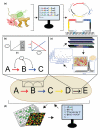Molecular tools for chemical biotechnology
- PMID: 23528237
- PMCID: PMC3740197
- DOI: 10.1016/j.copbio.2013.03.001
Molecular tools for chemical biotechnology
Abstract
Biotechnological production of high value chemical products increasingly involves engineering in vivo multi-enzyme pathways and host metabolism. Recent approaches to these engineering objectives have made use of molecular tools to advance de novo pathway identification, tunable enzyme expression, and rapid pathway construction. Molecular tools also enable optimization of single enzymes and entire genomes through diversity generation and screening, whole cell analytics, and synthetic metabolic control networks. In this review, we focus on advanced molecular tools and their applications to engineered pathways in host organisms, highlighting the degree to which each tool is generalizable.
Copyright © 2013 Elsevier Ltd. All rights reserved.
Figures

References
-
- Petersen M. Chemical biotechnology industrial applications and recent advances - Invited overview. Curr Opin Biotechnol. 1999;10:593–594.
-
- Bornscheuer UT, Huisman GW, Kazlauskas RJ, Lutz S, Moore JC, Robins K. Engineering the third wave of biocatalysis. Nature. 2012;485:185–194. - PubMed
-
- Nielsen J, Keasling JD. Synergies between synthetic biology and metabolic engineering. Nat Biotechnol. 2011;29:693–695. - PubMed
-
- Sun J, Shao Z, Zhao H, Nair N, Wen F, Xu JH. Cloning and characterization of a panel of constitutive promoters for applications in pathway engineering in Saccharomyces cerevisiae. Biotechnol Bioeng. 2012;109:2082–2092. - PubMed
Publication types
MeSH terms
Grants and funding
LinkOut - more resources
Full Text Sources
Other Literature Sources

